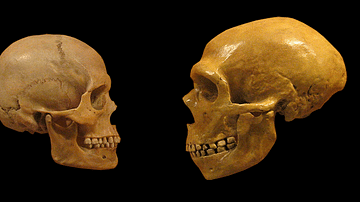Exploring our ancient origins has always been a fascinating endeavor, and one particular aspect that continues to captivate researchers is the connection between Neanderthals and Homo sapiens. This article delves into the intricate web of evidence that sheds light on this enigmatic relationship, providing valuable insights into our shared ancestry.
An Ancient Kinship Revealed through Genetic Analysis
In recent years, advancements in genetic analysis have revolutionized our understanding of human evolution. Through DNA sequencing techniques, scientists have unearthed compelling evidence supporting interbreeding between Neanderthals and early Homo sapiens populations. These findings challenge previous notions that these two groups existed in isolation from each other.
Genetic studies have revealed that individuals of non-African descent possess approximately 1-2% Neanderthal DNA within their genomes. This discovery suggests that interbreeding occurred after early humans migrated out of Africa around 60,000 years ago and encountered Neanderthal populations inhabiting Eurasia.
This genetic legacy provides crucial clues about the nature of interactions between these hominin species. It implies not only occasional encounters but also successful reproduction between them, indicating a level of compatibility necessary for viable offspring.
Cultural Exchange: Insights from Archaeological Discoveries
Beyond genetics, archaeological discoveries offer further glimpses into the complex dynamics between Neanderthals and Homo sapiens. Excavations at sites such as Denisova Cave in Siberia or Châtelperronian sites in Europe provide tangible evidence suggesting cultural exchange among these ancient human relatives.
Artifacts found at these locations exhibit a blend of characteristics associated with both groups—Neanderthal tools alongside those typically attributed to Homo sapiens. This coexistence of cultural elements suggests that Neanderthals and early humans not only interacted but also shared knowledge, technology, and perhaps even social practices.
Moreover, the discovery of cave paintings in Spain’s El Castillo Cave—dated back over 64,000 years—provides further evidence of a cognitive capacity for symbolic expression shared by both Neanderthals and Homo sapiens. These findings challenge previous assumptions about the exclusivity of certain intellectual abilities within our lineage.
The Legacy Lives On: Implications for Modern Humans
The connection between Neanderthals and Homo sapiens extends beyond mere historical curiosity; it has tangible implications for modern humans today. The genetic contributions inherited from our ancient relatives have been linked to various traits in present-day populations.
For instance, studies suggest that some Neanderthal DNA segments may influence susceptibility to certain diseases or conditions prevalent among non-African populations. Understanding these genetic legacies can aid medical research by shedding light on potential risk factors or protective mechanisms associated with specific health issues.
Furthermore, unraveling the intricacies of our ancestral connections fosters a sense of interconnectedness among diverse human groups worldwide. It reminds us that we are all part of an intricate tapestry woven through millennia—a testament to the resilience and adaptability inherent in our species’ journey across time.
In Conclusion
The connection between Neanderthals and Homo sapiens is far more than a distant chapter in human history—it is an ongoing story that continues to shape who we are today. Through genetic analysis and archaeological discoveries, we gain valuable insights into this complex relationship characterized by interbreeding, cultural exchange, and shared cognitive capacities. As we uncover more pieces of this puzzle, it becomes increasingly clear that our ancestry is intertwined with those who came before us, highlighting the remarkable journey of human evolution.
